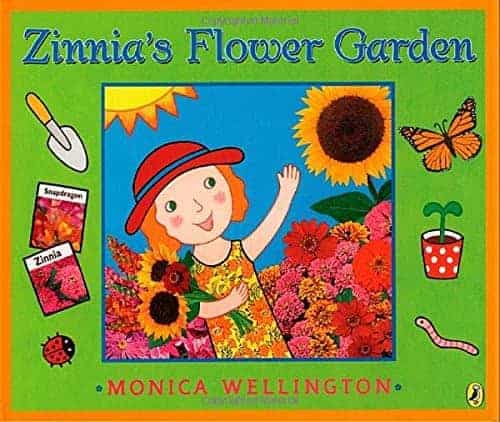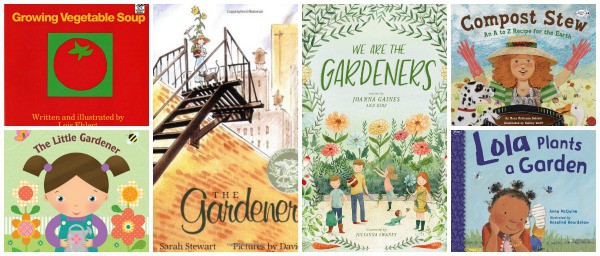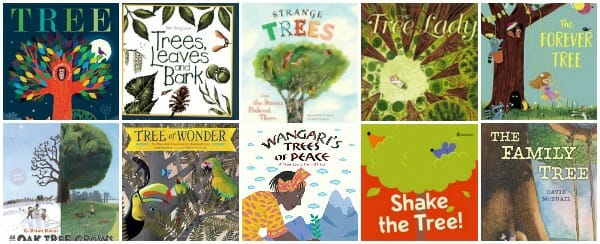Books for Kids About Growing Seeds and Plants
This post may contain affiliate links.
- Plant herbs inside all year round.
- Grow plants outside.
- Visit local plant and garden shops or a community garden.
Books for Kids About Growing Seeds and Plants

A Seed Will Grow written by Sabrina Moyle, illustrated by Eunice Moyle
Bright colors with lift the flap and pull the tabs will appeal to toddlers as they learn about seeds and plants. Sprinkle water, add some sun, watch the shoots and roots grow, and watch the pollinator butterflies and bees. Seeds feed animals and grow into other trees.

Plant the Tiny Seed by Christie Matheson
By the same author of Tap the Magic Tree and Touch the Brightest Star, you’ll get to use your imagination as you read and touch, rub, press, shake, clap, and more to help plant a garden. All the seeds need are water, rain, and sunshine to grow and you get to help.

Seeds by Carme Lemniscates
Read facts about actual seeds that grow plants. Then read about metaphorical seeds like smiles and anger. Both grow whatever seed is planted.

Do You Know Which Ones Will Grow? by Susan A. Shea, illustrated by Tom Slaughter
What is living and what isn’t? Only living things grow. Do you know the difference?

Miss Maple’s Seeds by Eliza Wheeler

Miguel’s Community Garden by JaNay Brown-Wood, illustrated by Samara Hardy
Explore the garden with Miguel in this interactive story while he searches for a sunflower. As you search, compare what you know about sunflowers with the other plants in the garden. You’ll learn about plants like artichokes, cherries, mulberries, spinach, and more. Finally, you find a tall flower with yellow petals, a round center, smooth green, and pointy leaves — you’ve found the sunflower! This is a delightful, educational introduction to plants in a garden with compare and contrast thinking.

Acorn Was a Little Wild by Jen Arena, illustrated by Jessica Gibson
This clever story of a wild little acorn teaches kids about plants and their life cycle. The acorn’s adventures result in a squirrel burying him. There in the dirt, he stays still, grows roots down, and grows above the ground into a tree.

Moving Words About a Flower by K.C. Hayes, illustrated by Barbara Chotiner
Shape poetry is beautifully arranged through the pages help readers understand a dandelion’s life cycle from seeds to pollination to growth. Use this in your plant and poetry curriculum as both informational text and a writing mentor text example.

Luke and the Little Seed by Guiliano Ferri
Luke’s grandfather gives him a seed that will turn into an exciting gift. When Luke gets sick, his friends help him water it and it turns into a huge tomato plant. A delightful and yummy gift!

Because of an Acorn by Lola M. Schaefer and Adam Schaefer, illustrated by Frann Preston-Gannon
Simple wisdom shows nature’s interconnectedness. Acorns turn into trees. Birds carry seeds that turn into flowers. Flowers turn into fruit which squirrels eat. Gorgeous muted, earthy illustrations.

And Then It’s Spring by Julie Fogliano, illustrated by Erin E. Stead
The illustrations perfectly capture this story of patience and transformation. A young boy and his dog watch the dull landscape and hopefully plant a seed. Slowly the pair watch and wait as the brown changes to a very possible sort of brown to a brown with a greenish hum “that you can only hear if you put your ear to the ground and close your eyes.” And finally, it’s green and spring.
 A Seed Grows by Antoinette Portis
A Seed Grows by Antoinette Portis
Simple and beautiful in its brevity, this circular story shows a seed growing from the dirt into a flower that is filled with seeds. The birds pick up the seeds, and some of the seeds drop back onto the dirt, ready to start the cycle all over again.

How to Be a Wildflower: A Field Guide by Katie Daisy
Beautifully designed, this book will inspire you and your kids to spend more time in nature. It includes activities, recipes, and quotes.

Anywhere Farm by Phyllis Root, illustrated by G. Brian Karas

Up in the Garden and Down in the Dirt by Kate Messner, illustrated by Christopher Silas Neal
See what’s happening both above and below ground as a little girl and her grandmother work in the garden from the beginning of the spring planting season until autumn gives way to cold snow. It’s an over-sized book with marvelous illustrations and juicy descriptions. “Down in the dirt, water soaks deep. Roots drink it in, and a long-legged spider stilt-walks over the streams.” Beautiful!

Zinnia’s Flower Garden
Read how Zinnia plants flower seeds, waits, and journals as her sprouts grow into flowers. As with all her books, notice not just the green sprouts but the other details in the illustrations like the family of robins who also are growing. The borders of the pages include information about the parts of a flower as well as the different kinds of flowers in Zinnia’s garden. In the fall, Zinnia finds the ripe seeds formed in the flowers that she’ll plant next year. In the winter, she plans for her spring flower garden.

Amazing Plants of the World by Stepanka Sekaninova, illustrated by Zuzana Dreadka Kruta
Narrated by an enthusiastic, quirky gardener, read about weird plants that stink, look peculiar, eat meat, mimic other things, and many more such oddities. The illustrations are accompanied by a lively description that gives pertinent facts while engaging readers with the gardener’s strong voice.

Caterpillar and Bean A First Science Storybook by Martin Jenkins, illustrated by Hannah Tolson
This is the story of a seed wedged in a crack in the ground that swells with the rain. Watch how the root pushes out the shoots and leaves. It’s an enthusiastic, lyrical story which develops several naturalist topics including seed and plant growth and the life cycle of a butterfly in this latest nonfiction picture book in Martin Jenkin’s First Science Storybook series.

All About Plants: Ada Twist, Scientist The Why Files by Andrea Beaty and Dr. Theanne Griffith
Packed full of information, this informational book hits the right spot for primary ages. Full-color photographs, diagrams, labels, cartoons, and informational text answer big questions like “How do they eat?” and “Do plants need air like me?“ I like this book — the writing and format are excellent. However, I’m disappointed the book doesn’t include a table of contents or a glossary.

Plant Pets written by Beatrice Boggs Allen and Belle Boggs
I love the concept of this book that plants aren’t just decor but pets. The illustrated book helps readers get started with supplies and care and then talks about the unique plants to consider for a pet. From pothos to an air plant (I love mine), you’ll learn about the pet, the challenges, the best containers, creative containers, similar species, propagating, cool facts, and other ways to use the plant, among other things. Read about plant food and soil, too. This is a kid-friendly and appealing guide to your first plant!











